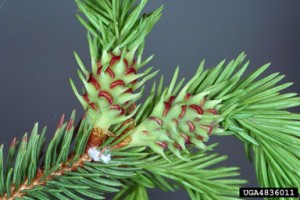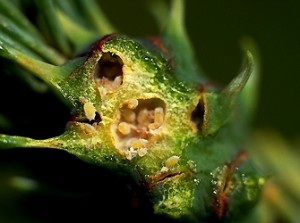
Eastern spruce gall adelgid
Eastern spruce gall adelgid (Adelges abietis)
The eastern spruce gall adelgid is primarily a pest of Norway spruce. It also occasionally damages Colorado blue, white, and red spruce. Since its introduction from Europe before 1900, it has spread throughout the northeastern US and southern Canada. The adelgid, which is closely related to aphids, causes galls to form at the base of new shoots. The gall may weaken the stem so that it will more readily break due to snow or wind. It is difficult to prune out the galls without disfiguring the tree. Galls may also distract from the beauty and symmetry of the tree. If abundant, the galls may reduce the vitality of the tree.
The adelgid overwinters as a partially grown female, sometimes called a stem mother, and matures in early spring. The female lays between 100-200 eggs about the time the buds break. The eggs are covered by a woolly wax-like substance. The eggs hatch in about ten days and the nymphs begin feeding on new needles. After a few days they move to the bases of the needles where their continued feeding induces the stem to produce the characteristic gall. The gall tissue grows completely around the nymphs protecting them from predators, parasites and the elements. The galls break open in mid to late summer and the nearly mature nymphs crawl out and transform into winged, egg-laying females. They lay their eggs near the tips of needles. Upon hatching, the nymphs attach themselves to a terminal twig near or at a dormant bud to spend the winter.
To control the adelgid, spray the tree(s) with Orthene or Tempo in late April or early May just after the buds break. A 2% summer oil spray can be used at this time but this is not as effective as Orthene or Tempo. If the problem persists, treat again in late August to September just after the galls open.
Be sure to read and follow all instructions and safety precautions found on the label before using any pesticide.





 Print
Print Email
Email




